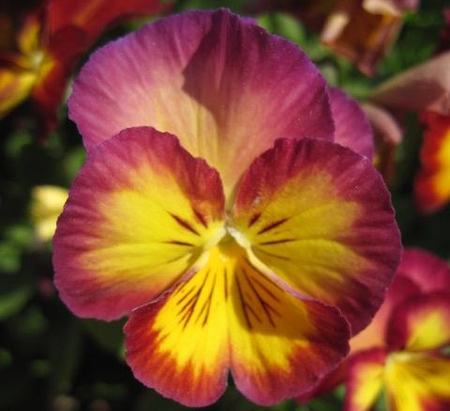Pansies are a winter favorite in Eastern North Carolina because they can survive cold winter temperatures and add a splash of color to the landscape. Pansies come in so many colors that it is hard to pass up getting at least a few to add to the landscape.
Pansies are usually planted in our area from late October thru November. These tough little plants do best in well-drained soils which can reduce chances of disease or root rot. Incorporating organic matter, like compost, into the soil before planting can improve soil and allow for better drainage.
Just because it is winter, does not mean you should forget about watering pansies during dry spells. However, it is just as important not to water too much which can quickly encourage disease problems. A good rule of thumb to know how much water pansies need is to water any time we have less than an inch of rain in a week. Avoid watering pansies in evenings or late afternoons because it does not allow enough time for the water to dry off of leaves before nightfall and will promote diseases.
When it comes to fertilizing pansies, many do not think much about the importance of fertilizing but it can however allow your pansies to flourish during the winter if applied correctly. Options for fertilizing pansies include slow-release and water soluble types of fertilizers. Slow-release fertilizers will slowly release into the soil over a period of time, while water soluble fertilizers will release nutrients more quickly. Slow-release fertilizers can be applied in two applications, once at planting and again midway through the growing season. Water soluble fertilizer should be applied every 1 to 4 weeks. Remember to always refer to the fertilizer label for directions on correctly applying fertilizer.
There are a couple of additional hints that can make your pansies perform well. One is to mulch around pansies to not only reduce weed problems but to conserve moisture in the soil. Also, do not forget to deadhead pansies during the season. Deadheading is the simple process of removing old flowers. Removing the old flowers allows the plants energy to go back into producing more flowers instead of producing seeds. Deadheading pansies will allow for more blooms longer into the winter season.
Following a few basic practices, like proper watering and fertilizing, can allow you to successfully grow pansies throughout the winter until warmer weather once again arrives.
Jessica Strickland is an Agriculture Extension Agent, specializing in horticulture for North Carolina Cooperative Extension in Wayne County.


